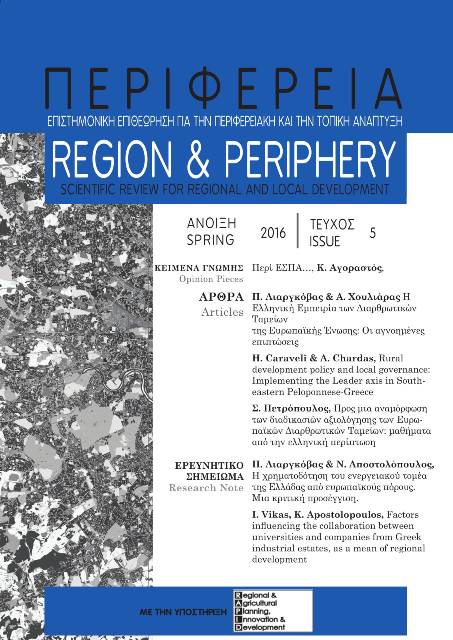Η Ελληνική Εμπειρία των Διαρθρωτικών Ταμείων της Ευρωπαϊκής Ένωσης: Οι αγνοημένες επιπτώσεις

Περίληψη
Διάφορες μελέτες και έρευνες έχουν εκτιμήσει τις επιπτώσεις των Διαρθρωτικών Ταμείων της ΕΕ στην ελληνική οικονομία. Κάποιες από αυτές (κοινοτικές κατά κύριο λόγο) εξετάζουν τις μικροοικονομικές επιπτώσεις συγκεκριμένων προγραμμάτων, ενώ άλλες (ακαδημαϊκές) επικεντρώνονται στις μακροοικονομικές επιπτώσεις - συνήθως στο εισόδημα και την απασχόληση. Κοινό χαρακτηριστικό και των δύο προσεγγίσεων είναι άποψη ότι τα Διαρθρωτικά Ταμεία αποτελούν μια καθαρά οικονομική παρέμβαση και επομένως επιφέρουν οικονομικές επιπτώσεις.Στο άρθρο αυτό υποστηρίζουμε ότι η ολοκληρωμένη διερεύνηση των επιπτώσεων των Διαρθρωτικών Ταμείων πρέπει να γίνεται από την πλευρά της πολιτικής οικονομίας.
Λεπτομέρειες άρθρου
- Πώς να δημιουργήσετε Αναφορές
-
Λιαργκόβας Π., & Χουλιαράς Α. (2018). Η Ελληνική Εμπειρία των Διαρθρωτικών Ταμείων της Ευρωπαϊκής Ένωσης: Οι αγνοημένες επιπτώσεις. Περιφέρεια | Regional Integration: Politics, Economics, Governance, (5), 9–19. https://doi.org/10.12681/rp.18473
- Ενότητα
- Ερευνητικά Άρθρα

Αυτή η εργασία είναι αδειοδοτημένη υπό το CC Αναφορά Δημιουργού – Μη Εμπορική Χρήση 4.0.
Οι συγγραφείς των άρθρων που δημοσιεύονται στο περιοδικό διατηρούν τα δικαιώματα πνευματικής ιδιοκτησίας επί των άρθρων τους, δίνοντας στο περιοδικό το δικαίωμα της πρώτης δημοσίευσης.
Άρθρα που δημοσιεύονται στο περιοδικό διατίθενται με άδεια Creative Commons 4.0 Non Commercial και σύμφωνα με την άδεια μπορούν να χρησιμοποιούνται ελεύθερα, με αναφορά στο/στη συγγραφέα και στην πρώτη δημοσίευση για μη κερδοσκοπικούς σκοπούς.
Οι συγγραφείς μπορούν να καταθέσουν το άρθρο σε ιδρυματικό ή άλλο αποθετήριο ή/και να το δημοσιεύσουν σε άλλη έκδοση, με υποχρεωτική την αναφορά πρώτης δημοσίευσης στο περιοδικό Περιφέρεια.
Οι συγγραφείς ενθαρρύνονται να καταθέσουν σε αποθετήριο ή να δημοσιεύσουν την εργασία τους στο διαδίκτυο πριν ή κατά τη διαδικασία υποβολής και αξιολόγησής της.


